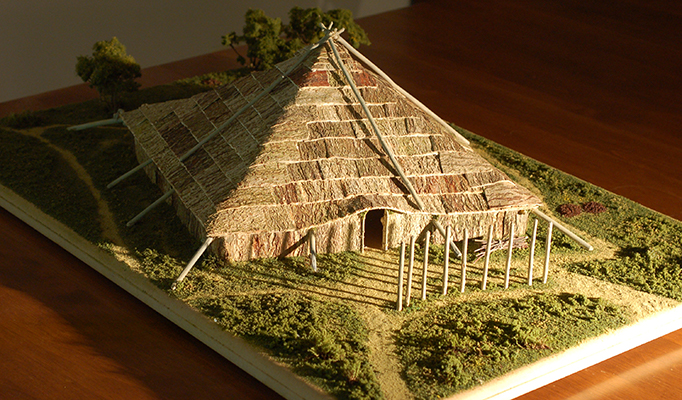Museum Curator of Archaeology Edits New Book on Ancient Ohio Civilization
By Brian G. Redmond, Ph.D.
John Otis Hower Chair and Curator of Archaeology

In 2016, the Ohio Archaeological Council (OAC), the organization of professional Ohio archaeologists, held a two-day conference on the Hopewell peoples of Ohio. The conference took place in Chillicothe, Ohio, one of the ancient centers of Hopewell culture in eastern North America.
The name “Ohio Hopewell” is used for a group of hunting, gathering, and farming societies that lived in the middle Ohio Valley some 2000 years ago. They are best known for the construction of huge geometric, earthen enclosures, or “geoglyphs,” along with hundreds of burial mounds. These peoples also made finely crafted religious artifacts using exotic raw materials such as copper, obsidian, mica, and marine shell. Although Hopewell archaeology has been around for more than a century, many questions remain about both the reasons for building the great earthen monuments and the more mundane aspects of people’s everyday lives. Thus, the OAC organized the 2016 conference to present some of the most recent research in Ohio Hopewell archaeology. From the more than 30 papers prepared for the conference, 19 were compiled for publication in a two-volume set titled
Encountering Hopewell in the Twenty-first Century.

Excavation of a ceremonial deposit of burned Hopewell pottery at the Moorehead Circle in the Fort Ancient Earthworks; Warren County, Ohio.

Small ceremonial mound of red soil found within the Hopewell Moorehead Circle in the Fort Ancient Earthworks; Warren County, Ohio.

Magnetometer map of Hopewell earthworks at the Seip site; Chillicothe, Ohio.

Hopewell cooking pit with Flint Ridge bladelet (at arrow) found at the Heckelman site; Milan, Ohio.

Hopewell stone tools from the Heckelman site; Milan, Ohio.

Decorated Hopewell and Woodland pottery sherds found at the Heckelman site; Milan, Ohio.

Photograph of scale model of Hopewell structure at the Brown’s Bottom site; Chillicothe, Ohio.
The chapters in
Encountering Hopewell address almost every aspect of this great ancient civilization. Among the topics covered in Volume One are new methods of geophysical prospecting (remote-sensing), LiDAR (aerial) mapping, and drone photography to better interpret ritual landscapes at famous centers such as Hopewell Mound Group, Fort Ancient, and Seip Earthworks. Recent excavations at the enigmatic Moorehead Circle within the Fort Ancient Earthworks provide surprising new insights about Hopewell monumental construction. Another study, by CMNH Research Associate Katharine Ruhl, explores the use of unusual copper ornaments found in a unique ritual deposit at the Seip Earthworks.
Elements of the Hopewell worldview are explored through archaeoastronomy and careful study of burial contexts.
Volume Two turns to the world of everyday settlements and domestic life at the Brown’s Bottom site in the Scioto River Valley, as well as farther afield in northern Ohio and southern Michigan. This section includes a chapter that I authored on the discovery of a Hopewell ceremonial center at the Heckelman site near Milan, Ohio. New evidence is also presented for long-distance pilgrimages by devotees between Hopewell centers in Ohio, Indiana, and Georgia. The relative importance of native seed plants in the economies of Ohio Hopewell communities is explored with new botanical and contextual data from recent research. The concluding chapter, by Dr. Mark Seeman, comments on the more seminal developments in Ohio Hopewell research since 2000, then turns an eye to the future.
Although written by professionals, the chapters in Encountering Hopewell are accessible to avocational archaeologists, students, and interested members of the public. The book includes more than 100 images of artifacts and archaeological excavations in Ohio and beyond. It sets the stage for a new century of archaeological research into the still-mysterious Hopewell people of Ohio.